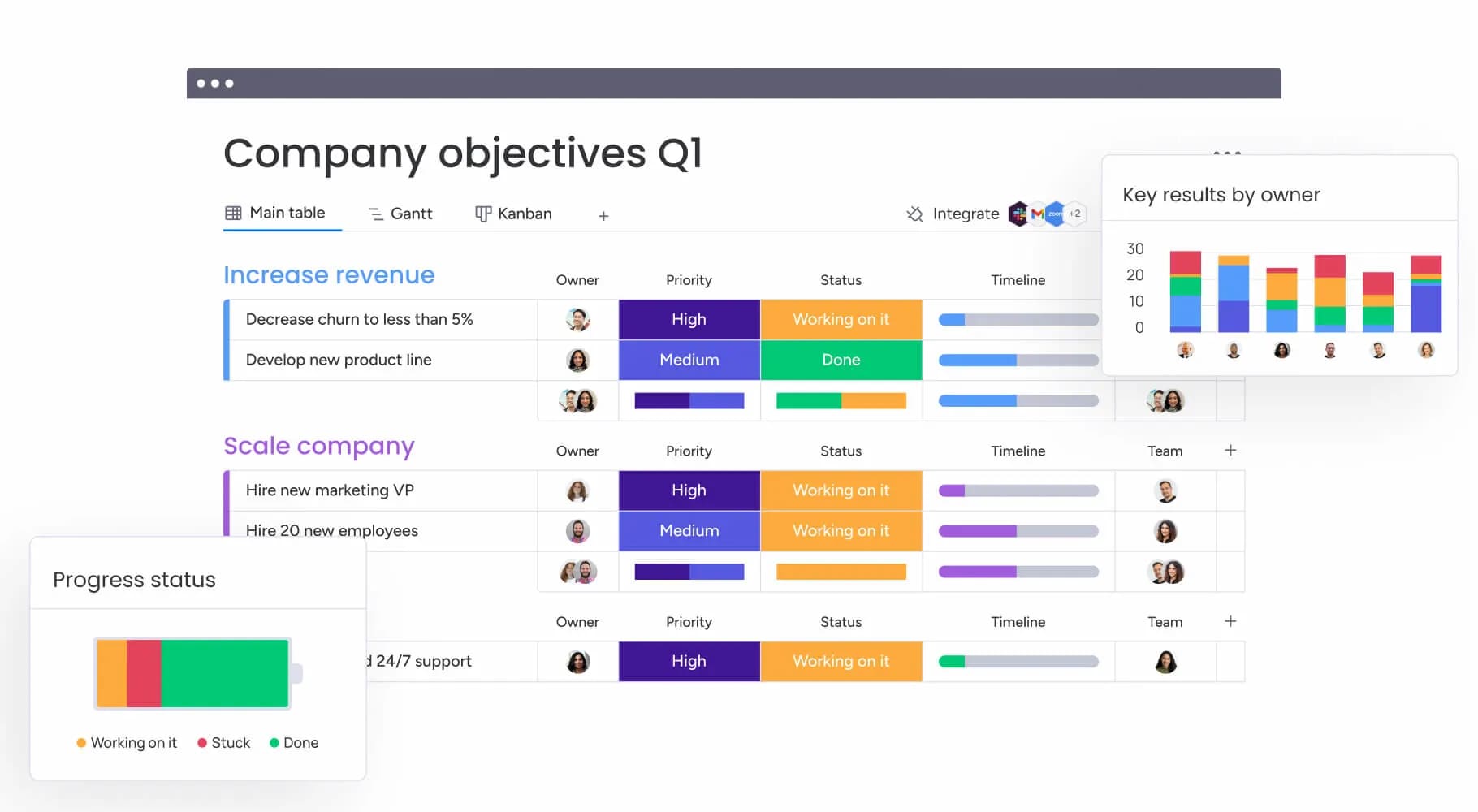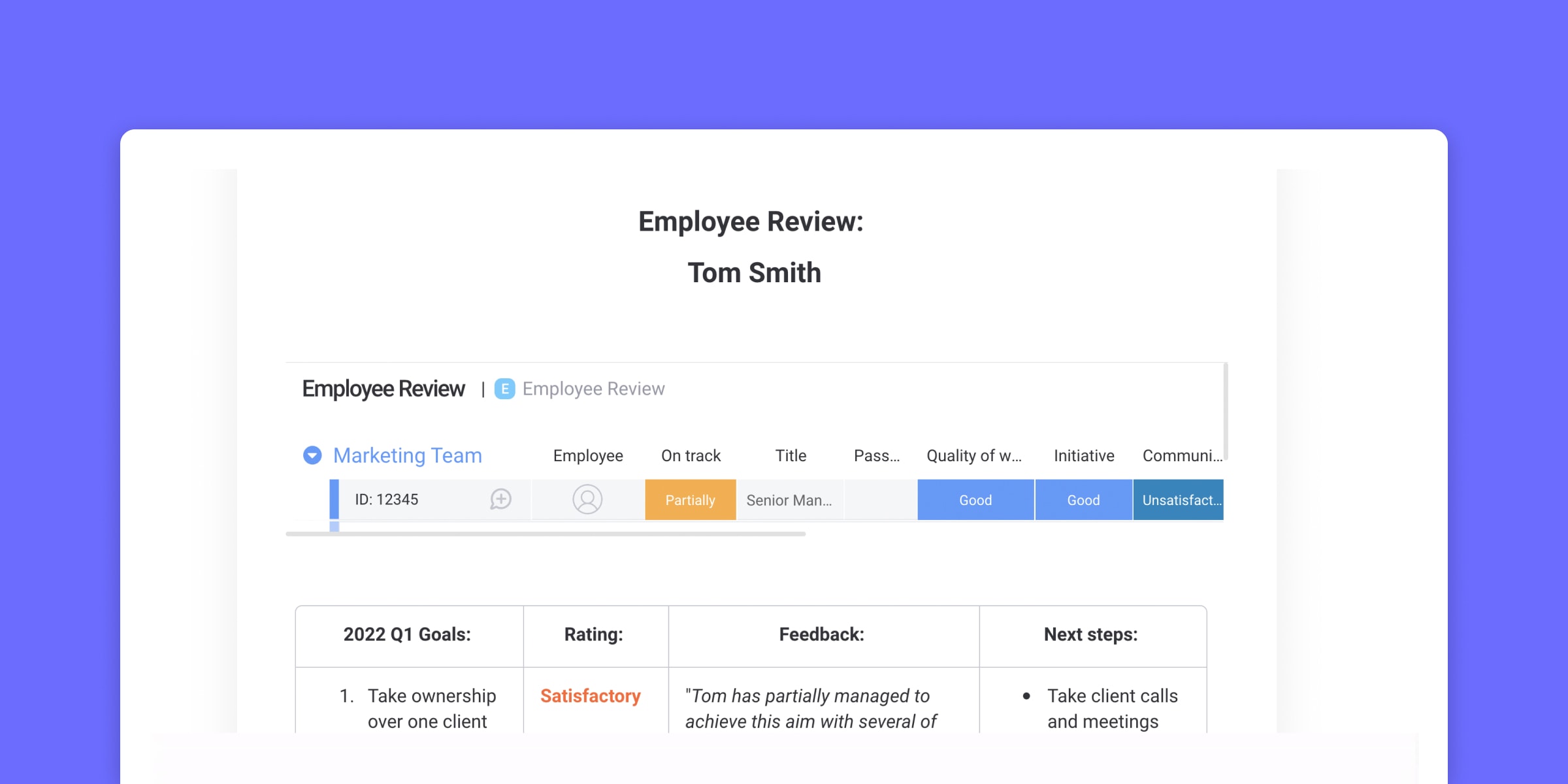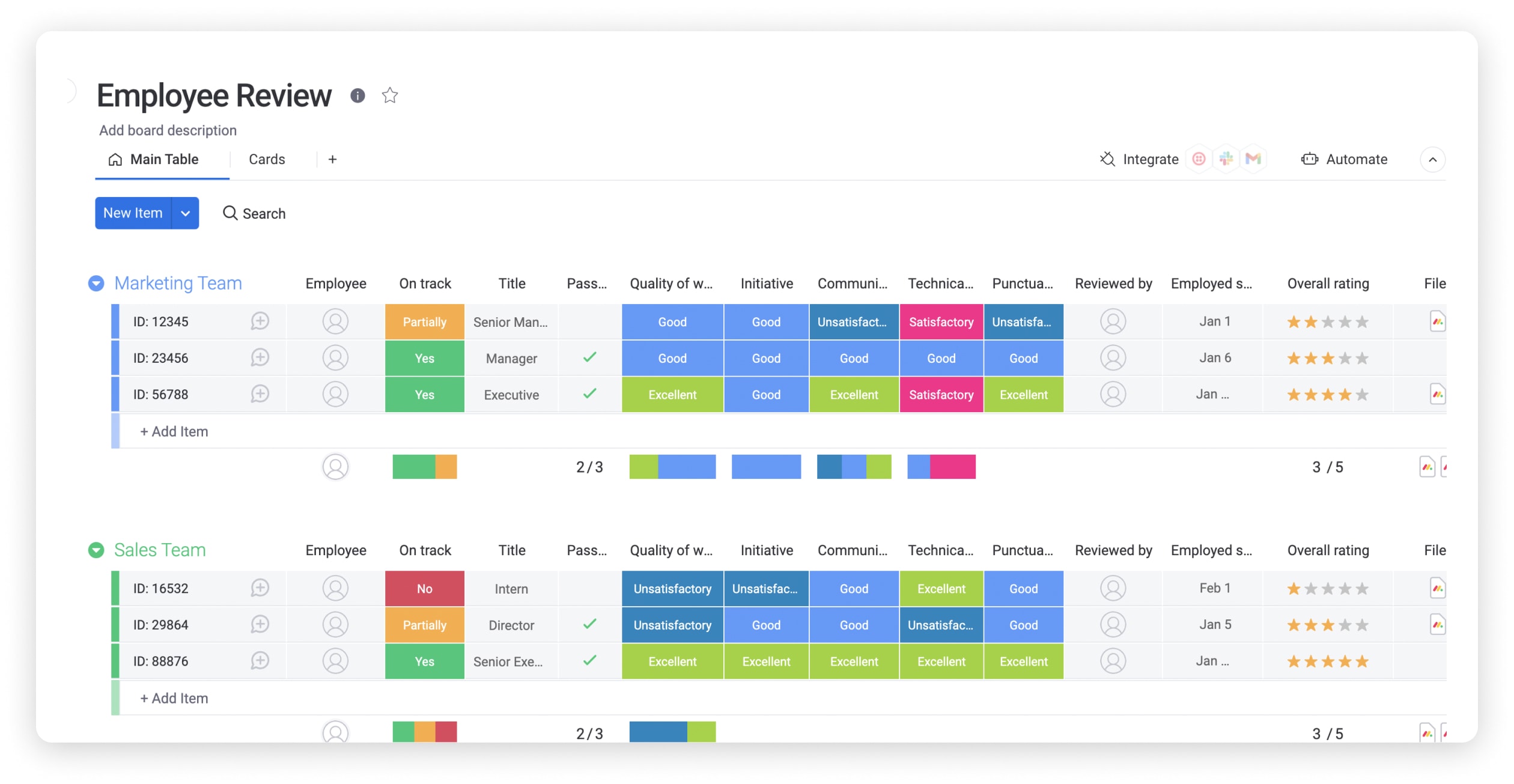Even the best strategic goals fall flat when daily work isn’t clearly connected to them, leading to lost momentum and unclear priorities. A modern performance management process bridges this gap by turning performance into an ongoing cycle of goal setting, feedback, and development. This keeps everyone aligned, accountable, and motivated, with research showing that employees who know how success is measured are twice as likely to feel engaged.
This guide covers the 5 key steps to effective performance management — from setting clear objectives to recognizing achievements — and shares best practices for implementation. You’ll also discover how a flexible work platform can integrate these processes seamlessly into your team’s everyday workflows.
Try monday work managementKey takeaways
- Performance management is not a once-a-year review. Focus on continuous goal-setting, feedback, and development to keep teams aligned and motivated year-round.
- The 5-step cycle — setting clear goals, monitoring progress, giving feedback, conducting reviews, and rewarding performance — connects daily work to business outcomes.
- Modern performance management boosts engagement and retention by creating clear career paths. Regular coaching conversations help employees grow instead of just being evaluated.
- Success requires leadership commitment and manager training as performance coaches. Executives must model the behavior while managers learn feedback and development skills.
- Eliminates manual spreadsheets and embeds performance management into daily workflows with monday work management’s automated tracking and transparent dashboards.
What is the performance management process
Performance management is an ongoing system where managers and employees collaborate to set goals, monitor progress, and evaluate performance; implementing a performance management system can further unify these efforts. With U.S. employee engagement falling to its lowest level in a decade in 2024, this process is critical for driving organizational success by moving beyond annual reviews to create a continuous cycle that connects individual work to company goals.
The performance management process includes 5 core components that work together throughout the year:
- Planning: Setting measurable objectives aligned with company strategy
- Monitoring: Tracking progress through regular check-ins and milestone reviews
- Developing: Building skills through coaching and growth opportunities
- Rating: Evaluating achievements against established goals
- Rewarding: Connecting performance to recognition and advancement
Unlike traditional once-a-year reviews, this approach keeps everyone aligned and accountable. Teams know exactly what success looks like and how their work contributes to larger objectives.
Performance management vs. performance appraisal
Performance management and performance appraisal serve different purposes, though many organizations confuse them. Understanding the distinction helps you choose the right approach for your teams.
Performance appraisal is a formal evaluation that happens once or twice per year. Managers assess past performance against predetermined goals and provide ratings for HR records.
Performance management is an ongoing process that includes goal setting, regular feedback, coaching, and development throughout the year. It focuses on continuous improvement rather than backward-looking evaluation.
| Performance management | Performance appraisal |
|---|---|
| Ongoing, continuous process | Annual or semi-annual event |
| Forward-looking development focus | Backward-looking evaluation |
| Regular feedback and coaching | Formal review meeting |
| Goal adjustment throughout year | Fixed goals for review period |
| Collaborative conversation | Manager-led assessment |
Organizations are shifting toward continuous performance management because it supports agility and responsiveness. When priorities change mid-year, you can adjust goals rather than waiting for the next review cycle.
Why modern performance management drives business success

Modern performance management transforms how organizations achieve results by creating direct connections between daily work and strategic outcomes. When you align individual contributions with business goals, everyone moves in the same direction.
Aligns teams with strategic goals
Performance management creates a cascading effect where company objectives flow down to team and individual levels. This alignment prevents departments from working in silos and ensures every project contributes to shared outcomes.
Through structured goal-setting processes, you eliminate confusion about priorities. Teams understand exactly which initiatives matter most and can focus their energy accordingly.
Boosts employee engagement and retention
Regular feedback helps employees see their value and understand career progression paths, which can significantly boost employee productivity. When people receive consistent coaching and recognition, they stay more engaged and committed to their roles.
Ongoing performance conversations also surface development opportunities early. You can address skill gaps before they become performance issues, keeping talent growing within your organization.
Creates accountability at every level
Clear ownership drives results. Performance management establishes who’s responsible for what, creating transparency that speeds up decision-making and problem resolution.
Regular check-ins mean issues surface quickly instead of festering until annual reviews. Teams can course-correct in real time, maintaining momentum toward their goals.
Real-world example: Let’s say a midsized healthcare provider introduces weekly feedback check-ins and ties recognition to training milestones. Within 6 months, employee engagement scores rise 18% and turnover drops significantly, showing how consistent performance conversations can directly improve retention and morale.
Enables data-driven decision making

Performance data guides critical decisions about promotions, compensation, and resource allocation, and leveraging performance management software can streamline these insights further. You can identify high performers, spot trends, and make strategic workforce planning decisions based on actual results.
This visibility helps leadership understand which teams need support and where to invest for maximum impact. monday work management centralizes this data, making it accessible for informed decision-making across the organization.
Try monday work managementThe 5 essential steps of performance management
Effective performance management follows a cyclical process that repeats throughout the year. Each step builds on the previous one to create a comprehensive system for driving results.
Step 1: Define clear goals and expectations
Goal-setting forms the foundation of performance management. You need specific, measurable objectives that connect individual work to organizational priorities.
Use the SMART framework to ensure goals are actionable:
- Specific: Define exactly what needs to be accomplished.
- Measurable: Include metrics that indicate success.
- Achievable: Set realistic targets based on resources and constraints.
- Relevant: Align with team and company objectives.
- Time-bound: Establish clear deadlines for completion.
Collaborative goal-setting increases buy-in and ensures objectives reflect both business needs and employee capabilities. When people help create their goals, they’re more committed to achieving them.
Step 2: Monitor progress continuously

Ongoing tracking keeps goals on track and provides opportunities for early intervention. Rather than waiting months to check progress, you maintain visibility throughout the performance period.
Effective monitoring combines multiple approaches:
- Weekly one-on-ones: Hold brief conversations about current priorities and obstacles.
- Milestone reviews: Ensure formal checkpoints at key project phases.
- Real-time dashboards: Rely on visual tracking of metrics and progress.
- Peer feedback: Gather input from colleagues on collaborative work.
The key is making monitoring supportive rather than surveillance. Focus on removing obstacles and providing resources, not just tracking completion rates.
Step 3: Deliver ongoing feedback and coaching
Feedback transforms performance management into development, and when challenges persist, implementing a performance improvement plan can clarify needed changes. When you provide timely, specific guidance, employees can adjust their approach and build new skills continuously.
Effective feedback follows these principles:
- Immediate timing: Address issues and celebrate wins as they happen.
- Specific examples: Reference particular behaviors or outcomes.
- Future-focused: Provide guidance for improvement.
- Two-way dialogue: Encourage questions and input.
Coaching goes beyond feedback to actively develop capabilities. Help employees identify learning opportunities, connect with mentors, and take on stretch assignments that build skills.
Step 4: Conduct performance reviews
Formal reviews document progress and plan for future development, and using an employee review template ensures consistency throughout the process. Since you’ve been providing feedback all year, reviews become productive planning sessions rather than surprising evaluations, a key strategy to improve work performance.
Review components should include:
- Goal achievement assessment: Evaluate progress against objectives.
- Competency evaluation: Review skills and behaviors demonstrated.
- Development discussion: Identify growth opportunities.
- Future planning: Set priorities for the next period.
You can streamline this process with monday work management’s customizable review templates and automated data collection while pulling performance data directly into reviews without manual compilation.
Step 5: Reward and develop your team
Connect performance outcomes to meaningful recognition and growth opportunities. This final step closes the loop and motivates continued excellence.
Recognition approaches that drive results:
- Compensation adjustments: Offer salary increases and bonuses tied to performance.
- Career advancement: Give promotions and expanded responsibilities.
- Skill development: Deliver training and certification opportunities.
- Public recognition: Prioritize team acknowledgment and achievement celebrations.
Development planning should align individual aspirations with organizational needs. Create specific learning objectives with timelines that support both personal growth and business goals.
Try monday work managementProven performance management methods
Organizations can choose from various approaches based on their culture and objectives. These methods can work individually or in combination for comprehensive performance management, supporting ongoing process improvement.
SMART goal setting
SMART criteria ensure goals drive action rather than create confusion. Instead of vague objectives like “improve performance,” SMART goals specify outcomes such as:
- Complete 3 advanced training modules by the end of Q2.
- Reduce customer support response times from 4 hours to 2 hours by next quarter.
- Mentor 2 junior teammates within 6 months.
These goals directly support employee growth and role effectiveness. This framework works because it eliminates ambiguity. Everyone understands exactly what success looks like and how to measure it.
Continuous performance management
This approach replaces annual reviews with ongoing conversations. Managers and employees discuss performance regularly, adjusting goals and addressing issues in real time.
Continuous management works particularly well in fast-changing environments where annual goals quickly become outdated. Teams stay agile and responsive to shifting priorities.
360-degree feedback
Multi-source feedback provides comprehensive performance insights. Input comes from managers, peers, direct reports, and sometimes customers, creating a complete picture of performance.
This method works best in collaborative environments where teamwork matters. It surfaces blind spots that managers alone might miss.
OKRs for performance alignment
Objectives and key results (OKRs) create transparency across organizations. Teams set ambitious objectives with measurable key results, typically on quarterly cycles.
OKRs complement individual performance goals by ensuring everyone understands how their work connects to company priorities.
Best practices for performance management implementation
Successful implementation requires more than choosing the right method. You need organizational commitment and systematic approaches that scale across teams.
Secure leadership commitment
Executive support drives adoption and cultural change. When leaders model performance management behaviors and allocate resources, it signals organizational priority.
Leadership commitment shows up through consistent participation in performance processes and public support for development initiatives. This visible engagement motivates managers and employees to take the process seriously, paving the way for stronger employee growth, higher engagement, and a culture of continuous improvement.
Train managers as performance coaches
Managers need different skills for coaching than for traditional supervision, and the right manager tools can support these evolving responsibilities. Essential capabilities include:
- Feedback delivery techniques: How to provide constructive guidance
- Goal-setting facilitation: Helping employees create meaningful objectives
- Difficult conversation navigation: Addressing performance issues professionally
- Development planning: Identifying growth opportunities and career paths
Regular training and practice help managers build these skills. Role-playing exercises and peer coaching accelerate capability development.
Leverage technology for scale
Manual performance management becomes unwieldy as organizations grow, highlighting the need for effective process management strategies. Technology platforms automate routine tasks and provide consistent processes across departments.
Smart software enables scalable performance management through automated workflows, standardized templates, and real-time reporting. AI adds another layer by summarizing feedback across multiple channels, surfacing coaching opportunities for managers, and even flagging early signs of burnout so teams can act before issues escalate.
Focus on employee development

Frame performance management as growth opportunity rather than evaluation. This shift reduces defensiveness and increases engagement with the process.
Development-focused approaches build stronger talent pipelines and improve retention. Employees see the organization investing in their future, not just measuring their output.
How monday work management revolutionizes performance management
Traditional performance management often relies on disconnected spreadsheets and manual tracking that create administrative burden without driving results, but monday work management embeds performance management where work already happens, reducing friction and improving adoption.
Automate performance tracking workflows
Automation eliminates repetitive tasks that slow down performance management. The platform automates review cycles, sends feedback reminders, and updates goal progress without manual intervention.
These automations ensure consistency while freeing managers to focus on coaching rather than administration. Custom workflows adapt to your organization’s specific processes and timelines.
Create transparent goal dashboards
Visual dashboards make goal progress visible across the organization. Teams see how their objectives connect to broader priorities, while managers track performance trends in real time.
This transparency drives accountability and motivation. When progress is visible, teams naturally align their efforts and support each other’s success.
Enable real-time feedback loops
The platform facilitates ongoing feedback through comments, updates, and notifications integrated into daily workflows. Feedback becomes part of regular work rather than a separate process.
Real-time capabilities mean issues get addressed immediately. You can course-correct quickly instead of waiting for scheduled review periods.
Build custom review processes

Every organization has unique performance management needs, and monday work management provides flexible templates and workflows that adapt to your specific requirements.
Customize review forms, automate approval processes, and generate reports tailored to your organization. The platform grows with you as your performance management practices evolve.
Try monday work managementStart building your performance management system
A structured performance management process transforms how your organization drives results and develops talent. By following the 5-step cycle — goal setting, progress monitoring, feedback, reviews, and rewards — you create accountability, growth, and alignment.
The key is making performance management part of daily work rather than an administrative burden. When teams have the right processes and platforms in place, performance management becomes a natural driver of success.
Simplify implementation with monday work management and get the structure, automation, and visibility you need. From goal tracking to review management, you’ll build a performance management system that scales with your organization.
Try monday work managementFAQs
What is the first step in the performance management process?
The first step in the performance management process is defining clear goals and expectations that align individual objectives with organizational strategy using frameworks like SMART goals.
How often should performance management conversations occur?
Performance management conversations should occur continuously through weekly one-on-ones and regular check-ins, with formal reviews conducted quarterly or annually based on organizational needs.
What is the difference between performance management and talent management?
Performance management focuses on current role effectiveness and goal achievement, while talent management encompasses broader career development, succession planning, and long-term organizational capability building.
How do you implement performance management for remote teams?
Implement performance management for remote teams through regular virtual check-ins, outcome-based evaluation rather than activity monitoring, collaborative goal-setting, and digital platforms that maintain visibility and connection.
What metrics indicate successful performance management?
Key metrics for successful performance management include goal achievement rates, employee engagement scores, retention rates, internal promotion rates, and manager effectiveness ratings from team feedback.
Can small businesses benefit from formal performance management processes?
Small businesses benefit from scaled-down performance management focusing on regular feedback, goal alignment, and development conversations without complex administrative requirements that larger organizations need.
 Get started
Get started 

